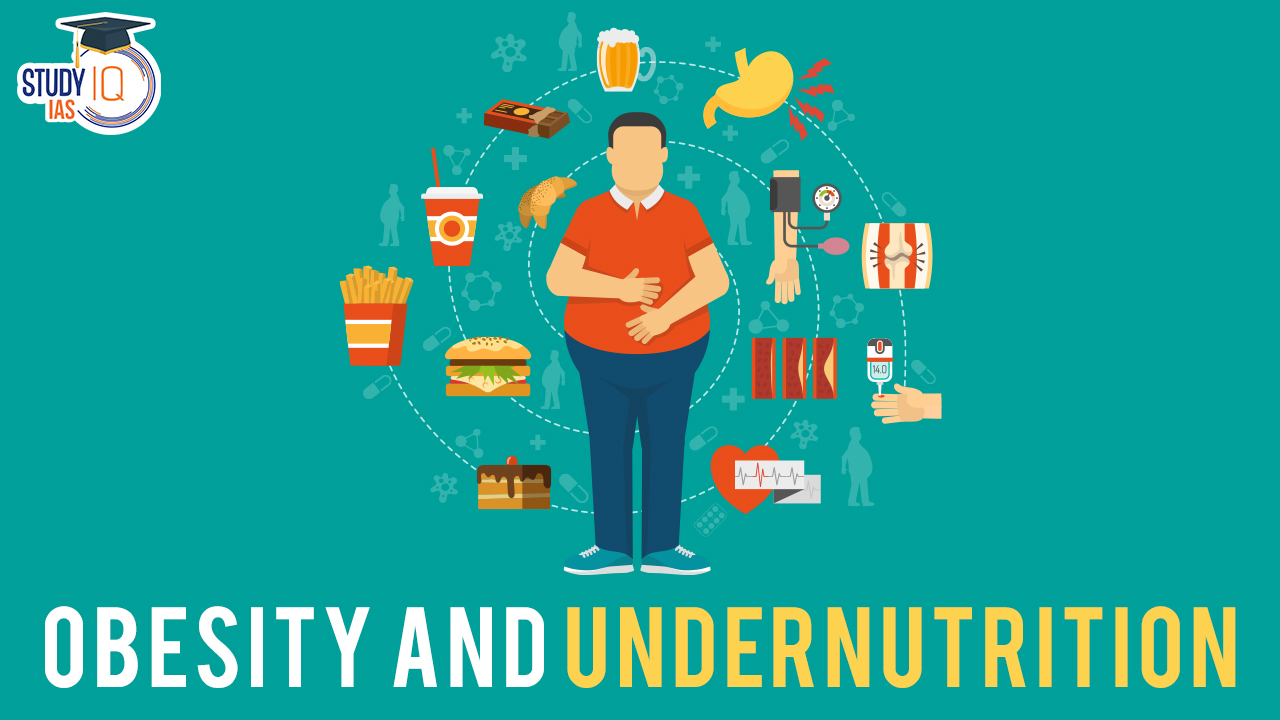Table of Contents
Context: Obesity and overweight are causing over 3.4 million deaths every year worldwide.
Obesity and Undernutrition
- India faces a growing challenge of both obesity and undernutrition, co-existing within the population, as per a new Lancet study.
- This phenomenon, known as the “double burden” of malnutrition, poses significant health risks.
| About Obesity |
|
Parameters of Obesity and Undernutrition
- Obesity: Defined by the World Health Organization (WHO) as an abnormal fat accumulation posing health risks.
- Adults: BMI ≥ 30 kg/m2
- Children/adolescents: BMI two standard deviations above the mean
- Undernutrition: Encompasses various forms, including underweight.
- Adults: BMI < 18 kg/m2
- Children/adolescents: BMI two standard deviations below the mean
Facts about Obesity and Undernutrition
Obesity
- Women: Increased from 1.2% (1990) to 9.8% (2022), with 44 million affected in 2022.
- Men: Increased by 4.9% (1990-2022), with 26 million affected in 2022.
- Children: Significant rise (3% in girls, 3.7% in boys) over 32 years.
- 2022: 3.1% of girls and 3.9% of boys obese (compared to 0.2 million each in 1990; 7.3 million boys and 5.2 million girls in 2022).
Undernutrition
- Despite the decline, prevalence remains high.
- 2022: 13.7% of women and 12.5% of men were underweight.
- Thinness (underweight in children):
- Highest in the world for girls (20.3%) and second highest for boys (21.7%).
We’re now on WhatsApp. Click to Join
Causes of Obesity and Undernutrition
- Lack of access to affordable, nutritious food: Contributes to both undernutrition and obesity.
- Undernutrition: Limited access to food itself.
- Obesity: Increased access to processed, unhealthy foods high in fat, sugar, and salt.
Socio-economic Factors
- Gender: Women have higher obesity rates due to:
- Limited access to physical activity (walks, gyms).
- Prioritising family nutrition over their own.
- Less sleep (waking up early, sleeping late).
- Central obesity (abdominal fat accumulation) might be as high as 40-50% in some regions.
- Income: While traditionally associated with the rich, obesity is rising among the poor due to:
- Affordability and convenience of junk food (e.g., samosas, pakoras) compared to fruits and vegetables.
- Urban-rural divide: Obesity is more prevalent in urban areas.
- Undernutrition: Persists in remote, rural areas of poorer states due to:
- Limited food access, with some people having only one meal a day.
Health Impacts of Obesity and Undernutrition
- Obesity: Increases risk of diabetes, hypertension, heart attacks, and strokes.
- Undernutrition: Increases the risk of non-communicable diseases later in life:
- “Catch-up growth” in adulthood may lead to bodies less able to adjust to increased nutrition, making them more susceptible to diseases like diabetes.
- This phenomenon has been observed in famines, where the rate of diabetes increases significantly years later in those born during the famine.
| Obesity Stats |
|
Solutions for Obesity and Undernutrition
- The study emphasises addressing both obesity and undernutrition simultaneously.
- Focus on programs promoting healthy nutrition:
- Targeted cash transfers.
- Food assistance (subsidies, vouchers for healthy foods).
- Free healthy school meals.
- Primary care-based nutritional interventions.
- Ensure food security.
- Support weight loss for those with obesity: Prevention and management are crucial due to the earlier onset of obesity, leading to longer exposure.
- Making healthy food affordable and accessible is a key challenge.
- Pharmacological treatment: While promising, the study suggests its limited impact due to high costs and lack of generalizable guidelines.


 Advanced Air Defence Radars: Types, Comp...
Advanced Air Defence Radars: Types, Comp...
 Ion Chromatography, Working and Applicat...
Ion Chromatography, Working and Applicat...
 Broadly Neutralising Antibodies (bNAbs):...
Broadly Neutralising Antibodies (bNAbs):...

























